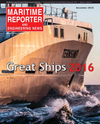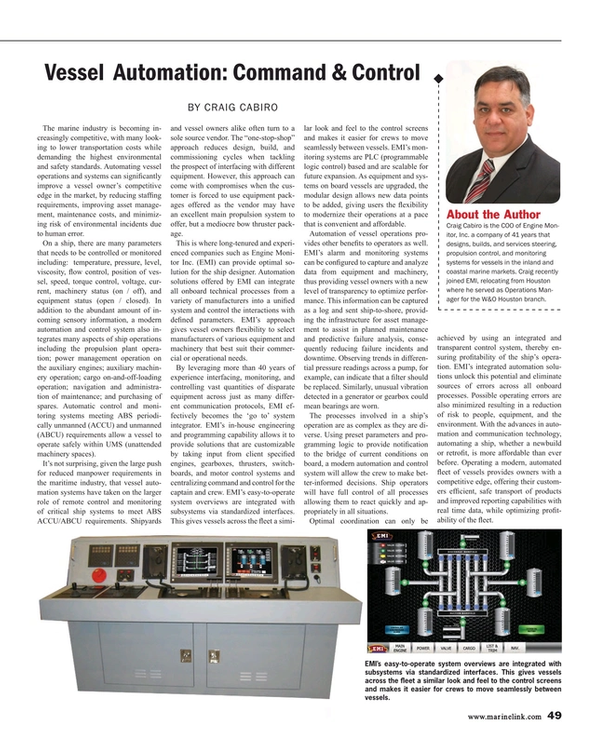
Vessel Automation: Command & Control
By Craig Cabiro
The marine industry is becoming increasingly competitive, with many looking to lower transportation costs while demanding the highest environmental and safety standards. Automating vessel operations and systems can significantly improve a vessel owner’s competitive edge in the market, by reducing staffing requirements, improving asset management, maintenance costs and minimizing risk of environmental incidents due to human error.
On a ship, there are many parameters that needs to be controlled or monitored including: temperature, pressure, level, viscosity, flow control, position of vessel, speed, torque control, voltage, current, machinery status (on / off), and equipment status (open / closed). In addition to the abundant amount of incoming sensory information, a modern automation and control system also integrates many aspects of ship operations including the propulsion plant operation; power management operation on the auxiliary engines; auxiliary machinery operation; cargo on-and-off-loading operation; navigation and administration of maintenance; and purchasing of spares. Automatic control and monitoring systems meeting ABS periodically unmanned (ACCU) and unmanned (ABCU) requirements allow a vessel to operate safely within UMS (unattended machinery spaces).
It’s not surprising, given the large push for reduced manpower requirements in the maritime industry, that vessel automation systems have taken on the larger role of remote control and monitoring of critical ship systems to meet ABS ACCU/ABCU requirements. Shipyards and vessel owners alike often turn to a sole source vendor. The “one-stop-shop” approach reduces design, build, and commissioning cycles when tackling the prospect of interfacing with different equipment. However, this approach can come with compromises when the customer is forced to use equipment packages offered as the vendor may have an excellent main propulsion system to offer, but a mediocre bow thruster package.
This is where long-tenured and experienced companies such as Engine Monitor Inc. (EMI) can provide optimal solution for the ship designer. Automation solutions offered by EMI can integrate all onboard technical processes from a variety of manufacturers into a unified system and control the interactions with defined parameters. EMI’s approach gives vessel owners flexibility to select manufacturers of various equipment and machinery that best suit their commercial or operational needs.
By leveraging more than 40 years of experience interfacing, monitoring, and controlling vast quantities of disparate equipment across just as many different communication protocols, EMI effectively becomes the ‘go to’ system integrator. EMI’s in-house engineering and programming capability allows it to provide solutions that are customizable by taking input from client specified engines, gearboxes, thrusters, switchboards, and motor control systems and centralizing command and control for the captain and crew. EMI’s easy-to-operate system overviews are integrated with subsystems via standardized interfaces. This gives vessels across the fleet a similar look and feel to the control screens and makes it easier for crews to move seamlessly between vessels. EMI’s monitoring systems are PLC (programmable logic control) based and are scalable for future expansion. As equipment and systems on board vessels are upgraded, the modular design allows new data points to be added, giving users the flexibility to modernize
their operations at a pace that is convenient and affordable.
Automation of vessel operations provides other benefits to operators as well. EMI’s alarm and monitoring systems can be configured to capture and analyze data from equipment and machinery, thus providing vessel owners with a new level of transparency to optimize performance. This information can be captured as a log and sent ship-to-shore, providing the infrastructure for asset management to assist in planned maintenance and predictive failure analysis, consequently reducing failure incidents and downtime. Observing trends in differential pressure readings across a pump, for example, can indicate that a filter should be replaced. Similarly, unusual vibration detected in a generator or gearbox could mean bearings are worn.
The processes involved in a ship’s operation are as complex as they are diverse. Using preset parameters and programming logic to provide notification to the bridge of current conditions on board, a modern automation and control system will allow the crew to make better-informed decisions. Ship operators will have full control of all processes allowing them to react quickly and appropriately in all situations.
Optimal coordination can only be achieved by using an integrated and transparent control system, thereby ensuring profitability of the ship’s operation. EMI’s integrated automation solutions unlock this potential and eliminate sources of errors across all onboard processes. Possible operating errors are also minimized resulting in a reduction of risk to people, equipment, and the environment. With the advances in automation and communication technology, automating a ship, whether a newbuild or retrofit, is more affordable than ever before. Operating a modern, automated fleet of vessels provides owners with a competitive edge, offering their customers efficient, safe transport of products and improved reporting capabilities with real time data, while optimizing profitability of the fleet.
The Author
Craig Cabiro is the COO of Engine Monitor, Inc. a company of 41 years that designs, builds, and services steering, propulsion control, and monitoring systems for vessels in the inland and coastal marine markets. Craig recently joined EMI, relocating from Houston where he served as Operations Manager for the W&O Houston branch.
(As published in the December 2016 edition of Maritime Reporter & Engineering News)
Read Vessel Automation: Command & Control in Pdf, Flash or Html5 edition of December 2016 Maritime Reporter
Other stories from December 2016 issue
Content
- Schottel's Strahberger: One Year at the Helm page: 20
- All Eyes on 2020 page: 24
- Great Ships of 2016: Ethane Crystal page: 31
- Great Ships of 2016: M/V Auto Eco page: 32
- Great Ships of 2016: Greenland page: 32
- Great Ships of 2016: Lindanger page: 33
- Great Ships of 2016: NYK Blue Jay page: 34
- Great Ships of 2016: Texas page: 34
- Great Ships of 2016: Carnival Vista page: 35
- Great Ships of 2016: Sunray page: 36
- Great Ships of 2016: Milos page: 36
- Great Ships of 2016: Polaris page: 37
- Great Ships of 2016: Seri Camellia page: 38
- Interview: Mika Koli, The Switch page: 42
- Great Ships of 2016: Ternsund page: 43
- OPC: Making Naval History page: 44
- Vessel Automation: Command & Control page: 49


